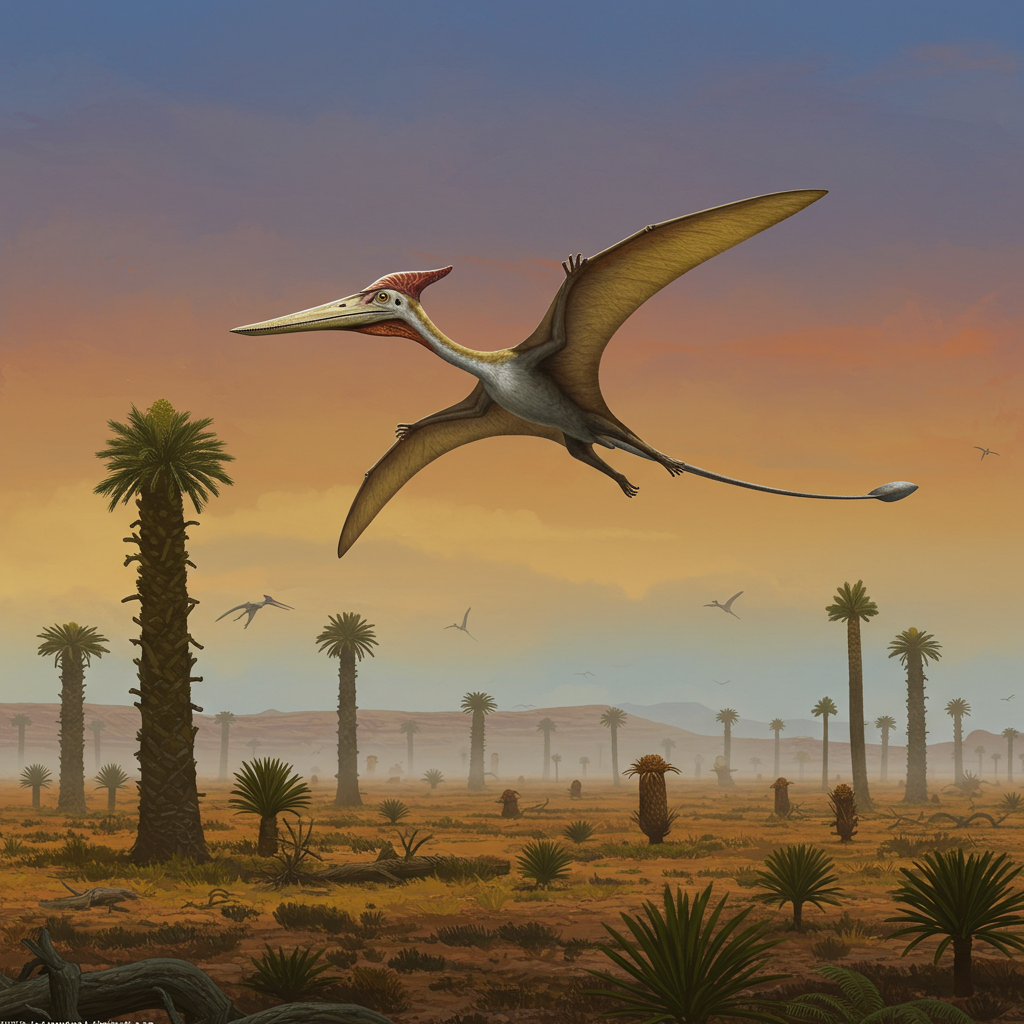A groundbreaking discovery is rewriting the story of ancient flight! Scientists have identified a new species of pterosaur, the winged reptiles that soared above the Earth more than 200 million years ago, sharing the planet with early dinosaurs. This incredible find, based on a small jawbone unearthed over a decade ago in Arizona, offers a crucial glimpse into the dawn of powered flight in North America.
The Discovery: Unearthing Ancient Secrets
The journey of this ancient fossil began back in 2011. Paleontologists working in Arizona discovered a fragmentary jawbone. At the time, the bone hinted at something significant, but its true identity remained elusive. It wasn’t until recently that researchers at the Smithsonian’s National Museum of Natural History applied sophisticated modern scanning techniques. These advanced methods allowed them to peer inside the fossil structure, revealing intricate details previously hidden. These details provided the clear evidence needed to confirm the jawbone belonged to a species entirely new to science. The lead author of the study detailing the find is Dr. Ben Kligman, a member of the research team that made this significant identification. The full scientific description of this remarkable creature has now been formally published, appearing in the prestigious scientific journal, Proceedings of the National Academy of Sciences.
Meet Eotephradactylus mcintireae: “Ash-Winged Dawn Goddess”
The newly identified ancient flyer has been given the formal scientific name Eotephradactylus mcintireae. This name carries deep meaning, translating roughly to “ash-winged dawn goddess.” It serves as a poignant reference. Part of the name honors Suzanne McIntire, the dedicated individual who originally found the jawbone in 2011. The “ash-winged” portion refers to the volcanic ash present at the fossil site. This ash played a vital role in preserving the delicate bones within an ancient riverbed for millennia.
Dating back approximately 209 million years, Eotephradactylus mcintireae holds a place of great significance. Scientists now believe this individual represents the earliest pterosaur ever found in North America. Finding fossils from Triassic pterosaurs is exceptionally rare. As Dr. Kligman explained, their bones were often small, thin, and even hollow. This delicate structure meant they were easily destroyed before they could be preserved through fossilization. Discoveries like this are therefore precious windows into a poorly understood period of pterosaur evolution.
A Window into the Triassic World: The Petrified Forest Site
The site where this remarkable jawbone was found is a fossil bed within the Petrified Forest National Park in Arizona. Today, it’s a landscape of ancient, arid rock. Millions of years ago, however, this area was dramatically different. It was a vibrant riverbed, part of the central region of the supercontinent Pangaea. This immense landmass comprised nearly all of Earth’s continents fused together. Over time, layers of sediment from the flowing river gradually accumulated. This process trapped and preserved a stunning variety of ancient life forms.
The pterosaur jawbone is just one piece of a much larger puzzle found at this single location. The fossil collection includes bones, teeth, fish scales, and even ancient fossilized waste, known as coprolites. This diverse assemblage provides incredible detail about the ecosystem that existed here over 200 million years ago. Dr. Kligman noted that successfully identifying pterosaur bones in these specific ancient river deposits is highly encouraging. It suggests there may be other similar Triassic rock formations around the world that could also hold preserved pterosaur bones waiting to be discovered.
What Did This Ancient Flyer Eat? Clues from Its Teeth
While only a jawbone, the fossil of Eotephradactylus mcintireae offered valuable clues about the creature itself. Based on its size, researchers estimate this early pterosaur was comparable in size to a modern-day seagull. Analysis of the teeth preserved in the jawbone provided fascinating insights into its diet. The teeth displayed an unusually high degree of wear at their tips. This wear pattern strongly suggests that this pterosaur fed on something with hard, robust body parts. Dr. Kligman indicated the most likely prey were primitive fish that lived in the rivers at the time. These ancient fish would have been covered in a protective armor of bony scales. Eating such fish would easily explain the significant wear observed on the pterosaur’s teeth. This dietary preference aligns with other early pterosaurs, which are believed to have hunted small aquatic life and insects.
More Than Just a Fossil: Understanding an Ecosystem in Transition
The fossil bed in the Petrified Forest National Park provides much more than just individual specimens. It preserves a remarkable “snapshot” of an entire ancient ecosystem. This site reveals a world where animal groups that are now long extinct lived side-by-side with the ancestors of animals we recognize today. Researchers found fossils of giant amphibians and ancient armored relatives of crocodiles alongside early forms of frogs and turtles.
Dr. Kligman describes this fossil bed as preserving evidence of a crucial evolutionary “transition.” Around 200 million years ago, during the Triassic period, the planet was changing. Animal groups that would later thrive and diversify were emerging. They were living alongside older lineages that ultimately did not survive past the end of the Triassic. Sites like this fossil bed are incredibly important. They enable scientists to establish definitively that these diverse groups of animals did, in fact, live together during this specific time in Earth’s history. This offers unique insights into how ecosystems evolve and change over millions of years.
Frequently Asked Questions
What is Eotephradactylus mcintireae and what does its name mean?
Eotephradactylus mcintireae is a newly discovered species of ancient flying reptile, a pterosaur. It lived about 209 million years ago during the Triassic period. Its scientific name translates to “ash-winged dawn goddess.” This name references the volcanic ash that helped preserve its bones and also honors Suzanne McIntire, the person who originally found the jawbone fossil in Arizona.
Where was this ancient pterosaur fossil found, and why is that location significant?
The fossil of Eotephradactylus mcintireae was found in a fossil bed within the Petrified Forest National Park in Arizona. This location was an ancient riverbed in the center of the supercontinent Pangaea over 200 million years ago. Its significance lies in preserving a diverse collection of fossils that provide a “snapshot” of an entire ecosystem from that time, including the earliest known North American pterosaur.
Why is the discovery of Eotephradactylus mcintireae considered important for paleontology?
This discovery is important for several reasons. At 209 million years old, it’s believed to be the oldest pterosaur fossil found in North America, shedding light on early pterosaur evolution. The rarity of Triassic pterosaur fossils makes any find significant. Furthermore, the fossil site offers a unique view of a Triassic ecosystem in transition, showing various extinct and early modern animal groups coexisting, which is crucial for understanding ancient biodiversity and evolutionary history.
The discovery of Eotephradactylus mcintireae highlights the power of both careful fieldwork and advanced technology in paleontology. This tiny jawbone, held for years, unlocked a major piece of the puzzle about when and how flying reptiles first took to the skies over North America. As scientists continue to study sites like the one in Petrified Forest National Park, and potentially find others like it around the world, our understanding of the Triassic world and the creatures that inhabited it will only continue to grow. This ancient “ash-winged dawn goddess” offers an exciting look back at a pivotal moment in Earth’s history.



